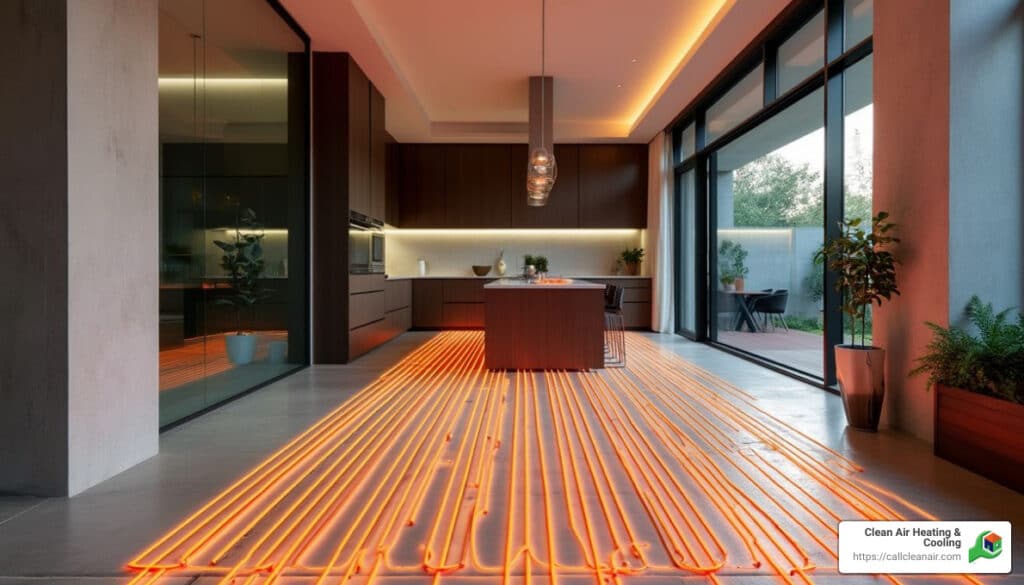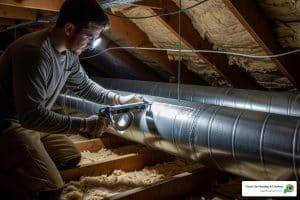Energy efficient floor heating is at the forefront of modern home comfort solutions, offering a sleek, unobtrusive way to keep your home warm. Here’s a quick rundown to meet your search intent:
- Types: Hydronic systems use water, while electric systems rely on cables or mats.
- Pros: Energy savings, uniform heating, and silent operation.
- Cons: High upfront cost, installation complexity, and possible increased floor height.
Radiant floor heating can transform cold, unwelcoming floors into delightful, warm surfaces. More energy-efficient than traditional methods, it provides consistently comfortable temperatures. Whether retrofitting in an existing home or building new, radiant heat systems can improve both energy efficiency and indoor climate control, especially in areas where extending ductwork is impractical. However, it’s worth noting that hydronic systems, while energy-efficient and ideal for broader applications, can be costly, whereas electric systems offer quick heating with flexibility for smaller spaces.
With ample expertise in the heating industry, I’m Colin Matei, owner of Clean Air Heating & Cooling. My passion lies in helping homeowners find custom solutions for energy efficient floor heating. This ensures comfort during the chilly months without skyrocketing utility bills. Now, let’s dive deeper into understanding what makes radiant floor heating so special and where it stands in today’s heating landscape.

Understanding Radiant Floor Heating
Radiant floor heating is a modern heating solution that delivers warmth directly through the floor. Unlike forced-air systems that blow warm air through vents, radiant heating systems warm the floor and radiate heat upward, creating a cozy environment.
Types of Radiant Floor Heating
There are three main types of radiant floor heating systems: hydronic, electric, and air-heated systems.
- Hydronic Systems: These use hot water circulated through pipes embedded in the floor. Hydronic systems are known for their efficiency and are often used in whole-house installations. They work well with various energy sources, including solar and natural gas. However, they can be complex and costly to install.
- Electric Systems: These systems use electric cables or heating mats placed beneath the floor. They are easier to install than hydronic systems and are ideal for single rooms or smaller spaces. Electric systems heat up quickly, making them suitable for areas like bathrooms or kitchens.
- Air-Heated Systems: This less common type uses warm air circulated beneath the floor. While not as energy-efficient as other types, air-heated systems can be useful in specific situations where other options are not feasible.
Pros and Cons of Radiant Floor Heating
Radiant floor heating offers several advantages, but there are also some drawbacks to consider.
Pros:
- Uniform Heating: Radiant systems provide even heat distribution across the entire floor, eliminating cold spots. This uniformity makes rooms feel consistently warm and comfortable.
- No Maintenance: Once installed, radiant floor systems typically require little to no maintenance. Unlike forced-air systems, there’s no need for regular filter changes or duct cleaning.
- Energy Efficiency: Radiant heating is highly efficient, often saving up to 25% more energy than traditional forced-air systems. This efficiency translates to lower energy bills.
- Silent Operation: Radiant systems operate quietly without the noise associated with traditional HVAC systems.
Cons:
- Cost: The initial installation cost of radiant floor heating can be high, especially for hydronic systems. However, the long-term energy savings often offset this expense.
- Floor Height: Installing radiant heating can slightly raise the floor height, which may be a concern in some renovations.
Radiant floor heating is a compelling choice for those seeking an energy-efficient way to heat their home. By understanding the different types of systems and weighing the pros and cons, you can decide if this heating method is right for your space.
Energy Efficient Floor Heating Systems
When it comes to keeping your home warm, energy efficient floor heating is a top choice. Two primary types of radiant floor heating systems lead the pack: hydronic and electric. Each has its unique strengths and ideal applications.
Hydronic Radiant Floor Heating
Hydronic systems are champions of energy efficiency. They use water-based systems, circulating hot water through a network of pipes embedded in the floor. This method is incredibly effective for whole-house heating.
Energy Sources: Hydronic systems are versatile, working well with various energy sources. You can use natural gas, oil, or even renewable options like solar thermal systems to heat the water. This flexibility can lead to significant energy savings, especially when paired with sustainable energy sources.
Installation Methods: Installing hydronic radiant floors can be a bit complex. There are several methods to consider:
- Concrete Embedding: Ideal for new constructions, pipes are embedded directly into the concrete slab. This method is efficient and durable.
- Subfloor Panels: For retrofits, pipes can be placed on top of the subfloor using grooved panels or snap-in grids.
- Joist Installation: Pipes can also be clipped into aluminum strips under the floor, suitable for certain architectural setups.
Electric Radiant Floor Heating
Electric radiant floor heating offers a different set of benefits, particularly in terms of installation ease and quick heating response.
Electric Cables and Heating Mats: These systems use electric cables or heating mats placed directly beneath the floor covering. They are perfect for spot-heating applications, like warming a bathroom or kitchen floor.
Installation Ease: One of the main advantages of electric systems is their simplicity. They are easier to install than hydronic systems, making them a popular choice for DIY enthusiasts. They are also ideal for retrofits or single-room applications.
- Quick Heat-Up: Electric systems heat up quickly, providing immediate comfort. This makes them well-suited for areas where you need fast, on-demand warmth.
Energy Consumption: While electric systems are 100% efficient in converting energy to heat, the cost of operation depends on the local electricity rates and the system’s wattage. It’s crucial to manage usage with programmable thermostats to maximize energy efficiency.
Both hydronic and electric radiant floor heating systems offer unique benefits. Hydronic systems are best for large areas and whole-house applications, while electric systems excel in specific rooms or smaller spaces. Each offers a way to accept energy-efficient, comfortable heating custom to your home’s needs.
Installation and Maintenance
Radiant floor heating is an excellent choice for those looking to improve comfort while maintaining energy efficiency. Whether you’re a DIY enthusiast or prefer professional installation, understanding the process and maintenance requirements can help you make informed decisions.
Areas to Install Radiant Floor Heating
Bathrooms: Stepping onto a warm floor after a shower can transform your daily routine. Bathrooms are ideal for radiant heating because they often have cold tile floors. Electric systems are particularly popular here due to their quick heat-up time and ease of installation.
Kitchens: As one of the most used rooms in a house, the kitchen benefits greatly from radiant floor heating. It not only keeps your feet warm but also helps maintain a cozy atmosphere. Both electric and hydronic systems can be installed, depending on your preference and existing infrastructure.
Basements: Basements are notorious for being cold and damp. Installing radiant floor heating can make these spaces more livable year-round. Hydronic systems are often recommended for basements, especially if you’re heating a large area.
Garages: While not the first place you might think to install radiant heating, garages can benefit significantly. A heated garage floor can help manage snow and ice during winter and provide a comfortable workspace. Both electric and hydronic systems can be used, depending on the garage’s size and your heating needs.
DIY Installation vs. Professional Installation
DIY Installation: Electric radiant floor heating systems are more accessible for DIY projects. Heating mats and cables can be installed under various floor coverings, and manufacturers often provide clear instructions. However, it’s crucial to have a basic understanding of electrical systems and follow all safety guidelines.
Professional Installation: For those less inclined toward DIY or dealing with complex setups like hydronic systems, hiring a professional is advisable. They can ensure the system is installed correctly and efficiently, avoiding potential issues down the line.
Maintenance-Free Benefits
One of the standout benefits of radiant floor heating is its low maintenance requirement. Once installed, there’s little you need to do. Unlike forced air systems, there are no filters to change or ducts to clean. Most systems come with a warranty ranging from 10 to 25 years, ensuring long-term peace of mind.
Radiant floor heating is a versatile and efficient way to improve the comfort of various spaces in your home. By understanding the best areas for installation and weighing the pros and cons of DIY versus professional installation, you can make the most of this heating solution.

Next, let’s address some common questions about energy-efficient floor heating to help you decide on the best system for your needs.
Frequently Asked Questions about Energy Efficient Floor Heating
What is the most energy efficient floor heating system?
When it comes to energy efficiency, hydronic radiant floor heating systems are often the top choice. These systems use water heated by a boiler or other energy sources, such as solar or geothermal, to circulate warmth through a network of tubes beneath the floor. The efficiency comes from the ability to use lower water temperatures while still providing comfortable heat. This makes hydronic systems particularly suitable for larger areas or whole-house heating.
Do heated floors use a lot of electricity?
Electric radiant floor heating systems are known for their efficiency, but they do consume electricity. In general, they use about 12 watts per hour per square foot. For a 100-square-foot room, this means about 1,200 watts per hour. However, the precise energy consumption depends on factors like room size, insulation, and desired temperature. Electric systems are advantageous for smaller spaces or specific rooms like bathrooms, where quick heat-up times are beneficial. Using a programmable thermostat can help manage electricity use by heating the floor only when necessary.
What is the cheapest way to heat floors?
For those prioritizing cost efficiency, hydronic heating systems are often the most economical option in the long run, especially for larger installations. While the upfront installation costs can be higher than electric systems, hydronic systems offer lower operating costs due to their efficient use of energy sources like natural gas or solar power. Over time, the savings on energy bills can offset the initial investment, making hydronic systems a cost-effective choice for many homeowners.
In conclusion, choosing the right radiant floor heating system involves considering both upfront costs and long-term efficiency. Whether you opt for hydronic or electric systems, each has its unique benefits custom to different needs and spaces.
Conclusion
At Clean Air Heating & Cooling, we’re committed to helping you achieve both comfort and energy savings. Our radiant floor heating solutions offer a modern, efficient way to keep your home warm without the bulk and noise of traditional systems.
Energy savings are not just about reducing your utility bills but also about making smart choices for the environment. Our hydronic and electric radiant floor heating systems are designed to maximize efficiency by using the least amount of energy necessary to maintain a comfortable temperature. With options like hydronic systems, which use water to distribute heat efficiently, or electric systems for targeted warmth, we ensure that each solution is custom to your specific needs.
Customer satisfaction is at the heart of what we do. With over 480 five-star Google reviews, we pride ourselves on delivering prompt, high-quality service. Our 25% utility savings guarantee reflects our confidence in the energy efficiency of our systems and our dedication to helping you save money.
Whether you’re considering radiant floor heating for your entire home or just a specific area like a bathroom or kitchen, we have the expertise and solutions to meet your needs. Ready to explore energy-efficient floor heating options? Contact us today to learn more about how we can help you achieve a cozy, cost-effective home environment.





